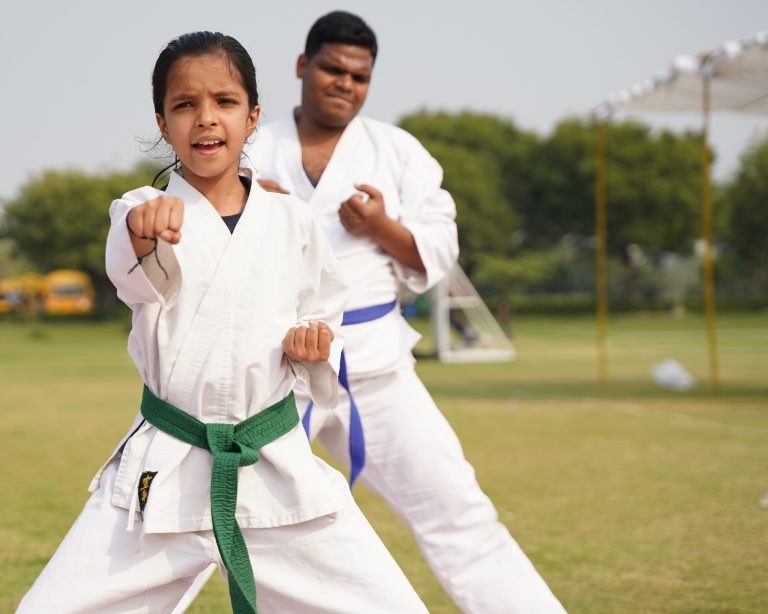How Are Karate Belts Earned?
Karate is a type of martial art that originated in Japan and has become popular all over the world. One of the most notable aspects of practicing karate is the belt system, which represents a student’s level of skill and experience. Karate belt colors typically range from white to black, with each color representing a different stage in a student’s journey towards mastery. In this blog post, we will explore the karate belt system and how belts are earned.
Overview of the Karate Belt System
The karate belt system is made up of several different colors, each representing a different rank or level of proficiency. Students typically start with a white belt and progress through several other colors, including yellow, orange, green, blue, purple, brown, and black. Black belt ranks can further be divided into degrees, with the highest degree being the tenth degree black belt.
Each belt color represents a different level of knowledge and skills in karate. A student with a white belt is considered a beginner and has just started learning basic techniques, while a black belt represents a high level of skill and mastery. Advancement to the next belt color is not automatic and requires the student to demonstrate a mastery of specific skills to their instructor.
How Are Karate Belts Earned?
Earning a new karate belt requires careful training and dedication. Every student is different, and every instructor may have different requirements for each belt. However, there are some common standards for earning each belt color that are followed by most karate schools. Let’s take a closer look at what’s required to earn each belt color.
White Belt
Every student starts with a white belt, which represents a blank slate and a willingness to learn. To advance to the next belt color, students need to demonstrate a basic understanding of fundamental karate techniques, including stances, punches, kicks, and blocks. Students also need to show basic strength, flexibility, and coordination.
Yellow Belt
The yellow belt represents a student’s first step towards becoming a more skilled karateka. To earn a yellow belt, students need to demonstrate their mastery of basic techniques and show a deeper understanding of karate’s philosophy and principles. They must also demonstrate increased strength, flexibility, and coordination.
Orange Belt
The orange belt is a significant advancement for a student, indicating that they are becoming more confident and self-assured in their karate practice. To earn an orange belt, students need to show proficiency in basic techniques and demonstrate an understanding of more advanced techniques, including joint locks and throws. They must also show increased strength, flexibility, and coordination.
Green Belt
The green belt represents a considerable achievement for a student, indicating that they are becoming more proficient in their karate practice. To earn a green belt, students need to show proficiency in basic and advanced techniques and demonstrate mastery of several katas (prearranged sequences of moves). They must also show increased strength, flexibility, coordination, and endurance.
Blue Belt
The blue belt is a major milestone for a karate student, indicating that they are becoming an advanced practitioner of the art. To earn a blue belt, students must demonstrate mastery of all basic and advanced techniques, along with several katas. They must also show increased strength, flexibility, coordination, and endurance.
Purple Belt
The purple belt represents a transition from an advanced student to an expert in karate. To earn a purple belt, students must demonstrate mastery of all basic and advanced techniques, katas, and sparring (kumite) skills. They must also show exceptional strength, flexibility, coordination, and endurance.
Brown Belt
The brown belt is the last level of the student ranks and represents a high level of proficiency in karate. To earn a brown belt, students must demonstrate mastery of all basic and advanced techniques, katas, and sparring skills. They must also show exceptional strength, flexibility, coordination, and endurance.
Black Belt
The black belt is the ultimate goal for any serious karate practitioner. It represents a high level of mastery and expertise in the art. To earn a black belt, students must demonstrate exceptional mastery of all basic and advanced techniques, katas, and sparring skills. They must also show exceptional strength, flexibility, coordination, and endurance.
In addition to demonstrating physical skill and knowledge, black belt candidates must also demonstrate a deep understanding of karate’s philosophy, principles, and history.
How Are Karate Belts Earned?
Introduction
Karate, a Japanese martial art, is known for ranking its practitioners using colored belts. The belt represents the degree of proficiency or skill level acquired by a practitioner. Each belt color indicates the level of the practitioner. Karate practitioners begin as white belts and progress through a series of rankings until they reach the highest rank, often represented by a black belt. However, many people may have questions about how one earns a karate belt. In this blog post, we will explore the most frequently asked questions related to earning karate belts.
What is the Purpose of a Karate Belt?
The karate belt system is set up to guide students in their development of skills, techniques, and knowledge in the art of karate. The belts help to mark the progress of the student and motivate them to continue their training. The different colored belts indicate the level of proficiency achieved by the student, with each level bringing a new set of challenges and skills to learn.
What are the Different Colored Belts in Karate?
The colored belts in karate are usually ranked as follows:
- White
- Yellow
- Orange
- Green
- Blue
- Purple
- Brown
- Black
What is Required to Move Up to the Next Belt?
Karate instructors set requirements for each colored belt level, which are usually based on skill level, attending classes, and time spent training. The requirements for each level will vary depending on each instructor, but generally include demonstrating proficiency in the following areas:
- Fundamental techniques (stances, punches, kicks, blocks)
- Kata (pre-arranged patterns of movement)
- Sparring (fighting exercises)
- Demonstration of strength and conditioning drills
- Knowledge of the history and philosophy of karate
How Long Does It Take to Earn Each Belt?
The time required to earn a belt may vary among different karate schools or organizations. However, there are general timelines that can be followed as a benchmark. It usually takes around three to six months for a new karate student to move from a white belt to a yellow belt, and another six to twelve months from yellow to orange. Orange to green belt can take anywhere from nine months to two years. The higher belt levels typically require more time, with black belt levels usually taking several years to achieve.
How is Progression Evaluated?
Evaluation of a student’s progress usually occurs in the form of progressive testing. The student will be tested on their skills and knowledge in the areas mentioned above, and must meet the requirements set by the instructor to advance to the next level. The evaluation process may also include participating in competitions and tournaments.
What is a “Sensei” and What is their Role in the Belt Ranking System?
A Sensei is a karate instructor or teacher. The Sensei is responsible for guiding the student in their learning process, evaluating their progress, and promoting them to the next level. Instructors use their knowledge and expertise to set the curriculum and requirements for each belt level. They are also responsible for mentoring their students in various aspects of martial arts training, including techniques, history, and philosophy.
How to Earn Your Karate Belt: A Step-by-Step Guide
Karate is a form of martial arts that requires years of dedicated training and practice to master. One of the most important aspects of karate is the belt system, which serves as a symbol of a student’s progress and accomplishments. In this guide, we’ll take a closer look at how you can earn your karate belt.
Step 1: Find a Reputable Dojo
The first step to earning your karate belt is finding a reputable dojo or training facility. Look for a dojo that has experienced instructors and a curriculum that aligns with your goals. Visit the dojo or attend a class to get a feel for the training and the environment. Make sure that the dojo has a legitimate affiliation with a recognized karate organization.
Step 2: Start Your Training
Once you have found a dojo, it’s time to start your training. Beginners typically start with the white belt, which represents a student’s innocence and lack of knowledge. During this stage, you will learn the basic techniques and forms that serve as the foundation for your karate training. Listen carefully to your instructor’s guidance, and practice regularly to improve your skills.
Step 3: Progress Through the Ranks
As you gain experience and improve your skills, you will progress through the belt ranks. The order of belt colors and the number of ranks may vary depending on the karate organization, but most follow a similar progression:
– White belt
– Yellow belt
– Orange belt
– Green belt
– Blue belt
– Purple belt
– Brown belt
– Black belt
Each belt level represents a deeper understanding of the art and a higher level of skill. As you progress, your instructor will test you on your technique, form, and knowledge of karate. You may also be required to spar with other students to demonstrate your proficiency.
Step 4: Attend Regular Classes and Practice Consistently
Earning your karate belt requires regular attendance and consistent practice. Attend classes as often as possible, and practice outside of class to refine your skills. Karate is a physical and mental discipline, so make sure to take care of your body and mind by eating nutritious food, getting enough sleep, and managing your stress.
Step 5: Demonstrate Your Knowledge and Skill to Your Instructor
When you are ready to test for a new belt rank, you will demonstrate your knowledge and skill to your instructor. The testing process may vary depending on the dojo and the karate organization, but it typically includes a combination of written exams, demonstrations of technique and form, and sparring. Your instructor will evaluate your performance and determine whether you are ready to advance to the next belt level.
Step 6: Continue Learning and Growing as a Martial Artist
Earning a black belt is a significant achievement in karate, but it is not the end of the journey. As a martial artist, you should always strive to learn and grow. Attend seminars and workshops, study the history of karate, and train with other experienced practitioners. By continuing your education and training, you can deepen your understanding of karate and become a more skilled and knowledgeable martial artist.
Conclusion
Earning your karate belt requires dedication, hard work, and a commitment to personal growth. By following these six steps and continuing to train and learn, you can progress through the belt ranks and become a skilled and accomplished martial artist. Remember to always respect your instructor, your fellow students, and the traditions of karate. With time and dedication, you can achieve your goals and earn your place in the long and storied history of this martial art.
Inhaltsverzeichnis





